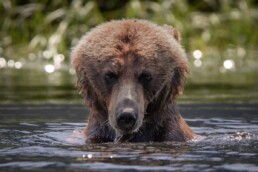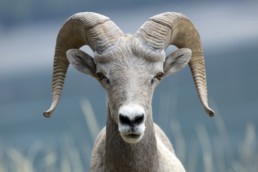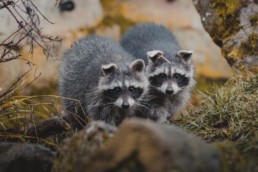Despite the “American” in their name, American black bears are one of the most common large animals seen in the Canadian city of Castlegar, British Columbia.
Castlegar’s lush valley bottoms provide ideal black bear habitat and ample food sources. While dangerous encounters with bears are rare, conflict is common when bears are allowed to access unnatural foods, such as household garbage and backyard birdseed. Black bears tend to use riparian and forested corridors to move through settled areas, but they can also be encountered all over town, especially in the late summer and fall. Below are more facts about these impressive animals provided by Jenny Wallace, former Community Coordinator at WildSafeBC.
Also known as:
- Ursus americanus
- nupqu (Ktunaxa language)
- kenkéknem (Secwepemctsin language)
- skǝmixist (nsyilxcǝn language)
Description:
- Coat can be a range of colours, including black, blonde, cinnamon, or dark brown.
- Rounded ears, small eyes.
- Relatively straight nose profile compared to the dish-shaped face of a grizzly.
- Adult males weigh 80-300 kg, measuring 60-90cm at the shoulder and 130-190cm long. Females tend to be smaller, weighing 40-140kg.
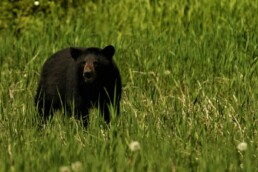
Habitat:
- Black bears utilize a wide variety of habitats, but prefer wooded areas and mixed forests with ample food sources.
- Hibernate in dens, under fallen trees, tree cavities, brush piles, and often underneath the branches of snow laden trees.
- Male home range is 100km² or more, while females’ home range is much smaller 10-40km².
Viewing Opportunities:
- The river shoreline is a major bear corridor through Castlegar, allowing bears to pass through town and access food sources. Try scanning the shoreline with binoculars, or watch from a good vantage point, such as Zuckerberg Island dyke and the riverfront benches in Millennium Park.
- Go for an early morning or evening drive up to Bombi Pass or Paulson Pass. Both roads pass through prime bear habitat and bears are often drawn to the early vegetation along roadsides in spring.
- Bear encounters are possible literally anywhere in Castlegar. Be prepared for encounters by reading the tips below.
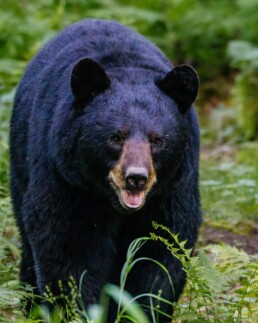
Behaviour:
- Black bears are solitary, except for sows with cubs who stay together for 1.5 years. Siblings may remain together for a short time after dispersal.
- Omnivorous. Bears require a huge amount of food especially in the late summer/fall to build winter reserves.
- Black bears are not true hibernators, going into a state of torpor where they do not eat or drink, but they do wake up and move around a bit in the den everyday.
- Females tend to give birth to 1-3 cubs during hibernation. The number of cubs is directly related to her body condition in the fall.
- Black bears can live 25-30 years in captivity, but lifespans are much shorter in the wild.
Diet:
- Black bears are classified as carnivores, and will eat fish, small mammals, newborn ungulates and carrion.
- However, black bears are truthfully omnivorous, with a diet largely composed of plants.
- The plants they prefer are grass, dandelion, skunk cabbage and berries. They also eat insects such as bees, ants and moths.
Connections:
- Despite their size, bears tend to avoid people. While bear encounters are common around Castlegar, bear attacks are extremely rare.
- Due to their huge food requirements, bears can easily become food conditioned when they find unnatural food sources (eg: garbage, birdseed, domestic fruit) in human-settled areas. Bears are destroyed each year as a result of preventable conflict.
- Castlegar is one of 11 “Bear Smart Communities” in BC, a title awarded to communities that have committed to reducing wildlife attractants in the community through initiatives such as bear-resistant garbage cans (every park and household has one!); bylaws that regulate the management of garbage, birdfeeders and fruit trees; and an official commitment to reducing conflict in the long term.
- To the Sylix people, black bears represent the importance of tradition and contemplation of the past and future.
Cool Facts:
- One black bear can consume up to 20,000 calories a day during hyperphagia (pre-hibernation food frenzy).
- Black bears experience ‘delayed implantation’. While they breed in the summer, the female will not actually become pregnant until the fall, provided she puts on enough fat reserves to sustain the pregnancy.
- Females are more tolerant of female cubs remaining close to their range after dispersal, but will chase off male cubs.
- Bear scat provides major seed dispersal service: one researcher managed to sprout 1,200 seedlings from the seeds in one pile of bear scat!
- While “hibernating,” bears do not eat, drink or urinate/defecate for up to six months but they do get up every day to reposition and move about.
- Black bears have an extremely keen sense of smell. In fact, some estimates suggest a bear’s sense of smell is 7 times greater than a bloodhound’s!
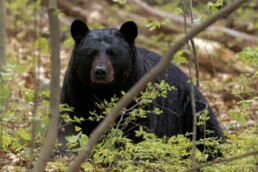
The goal of wildlife viewing is to safely appreciate the animals in their natural surroundings with minimal impact. To achieve that, here are eight tips:
- Be respectful. Getting too close or staying too long can disrupt feeding and other important behaviours and can cause stress and unpredictable behaviour.
- Give wildlife lots of space. If an animal responds to your presence (eg: looks up, watches you, moves away), you are too close.
- Viewing roadside wildlife can have negative impacts on wildlife by disrupting feeding and leading to habituation to traffic and people. If you spot wildlife while driving, pull over only if it is safe to do so and keep your stop short and sweet.
- Keep dogs on leash and under control at all times to avoid negative encounters
- Carry bear spray and know how to use it.
- Use binoculars and zoom lenses.
- Never feed wildlife.
- Leave no trace. Pack it in, pack it out.
Meet Castlegar Photographer Josh Fogal
March 15, 2024
Meet Josh Fogal. He's only been doing photography for 3 years but he already has his work hanging in the Kootenay Gallery.
0 Comments4 Minutes
Stefanie Harron Shares Her Wildlife Photography Secrets
May 30, 2022
Stefanie Harron is a Castlegar-based photographer who specializes in capturing landscape, wildlife and astral images.
0 Comments5 Minutes
Where To See Wildlife In The Fall in Castlegar
Out & About,Featured Story,Fall
October 12, 2021
Autumn is a special time in Castlegar because it's the best season to spot all manner of wildlife in and around the city. Here's what you can expect to see and where.
0 Comments5 Minutes


